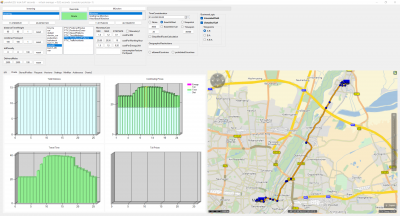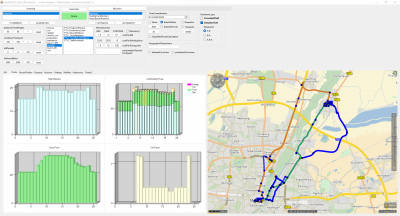Page 1 of 1
Plantour with PTV_Speedpatterns
Posted: Fri May 22, 2020 12:44 pm
by Freund
Hi,
is it possible to plan tours with SpeedPatterns, TrafficIncidents, RestrictionZones and TruckAttributes?
Regards,
Christian
Re: Plantour with PTV_Speedpatterns
Posted: Fri May 22, 2020 5:27 pm
by Bernd Welter
Hello Christian,
well, in xTour.planTours you can refer to a distance matrix which is based on the feature layers and also those which refer to TimeDependency but you should be aware of what that means. Please ensure to have read and understood the meaning of TimeConsiderationMode.
Imagine you created a distance matrix with TimeConsiderationMode.ExactAtStart: this means that each relation would reflect the driving time & distance from a start location to all destinations with the street conditions that match the time after start.
Let's say you created an Urban Dima based on 08:00 with SpeedPatterns. All segments and relations would more or less cover the "commuter conditions" though you might try to apply this dima on a vehicles 08:00 to 17:00 period.
In other words: the dima covers "inbound traffic" though you might expect the tour optimization to handle relations different when applied on an afternoon section.
I recommend to discuss your usecase scenario with your assigned consultant or Technical Partner Manager (me?)
Best regards,
Bernd
Re: Plantour with PTV_Speedpatterns
Posted: Thu Jun 16, 2022 10:04 am
by Bernd Welter
Short update: in v2.20 we invented a
new time consideration mode:
Check
com.ptvgroup.xserver.timeconsideration.MultipleTravelTimesConsideration
This mode (combined with any daytime dependent data such as PTV_TruckSpeedPatterns ...) enables you to create a distance matrix which stores not only a single value of distance and traveltime per relation:
It enables you to gather a stable distance(x1,y1,x2,y2) plus a variable traveltime (x1,y1,x2,y2,
referencetime). In other words:
- We first compute the reference geometries of the routes.
- Then we apply the daytime dependency on the geometry based on the reference time

Please be aware the the geometry off the routes do not depend on the time of the day!

- 25 routings starting at 00:00, 01:00, 02:00... The first routing provided an encoded path object which is then used to enforce all succeeding routings to folow the same track. This is how a Multitraveltime distance matrix would create the information. All distances are equal, the worst traveltime is about 40minutes

- In this approach I did not reuse the encoded path. All 25 routings choose the optimal path depending on the time of the day. We encounter different geometries. And also the worst "traveltime" is about 33 minutes
Bernd